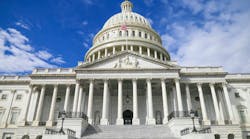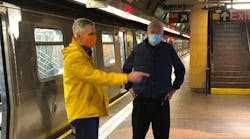New York MTA lays out dispiriting 2021 budget proposal with drastic cuts to service and staff levels
The financial crisis brought on by the COVID-19 pandemic easily eclipses the Great Depression’s impact on transit revenue and ridership according to the Metropolitan Transportation Authority (MTA), which laid out a budget proposal for 2021 that could leave thousands of employees without jobs, as well as cuts to service between 40 and 50 percent.
Cumulative deficits for the MTA are now expected to reach $15.9 billion by 2024 with the biggest blow expected in 2021 with a $6.121 billion deficit.
A plan provided in May by the transit authority assumed an additional $12 billion in federal stimulus aid would come by the end of the year. In the absence of additional federal funds, MTA has revised its financial plan that incorporates service and staff reductions, increased borrowing, cost cutting initiatives and a continued pause to the authority’s $51.5 billion capital plan.
“The numbers speak for themselves; we are approaching a point where these draconian options will have to be implemented to ensure our survival,” said MTA Chief Financial Officer Bob Foran. “Not receiving the billions we desperately need to survive would stunt the tangible progress we have made in service quality and infrastructure improvements. We can’t afford to let that happen.”
What do the numbers say?
MTA’s November Plan estimates deficits of $2.49 billion in 2020, $6.12 billion in 2021, $3.61 billion in 2022, $1.78 billion in 2023 and $1.92 billion in 2024. With cost cutting initiatives implemented and identified, MTA believes it can reduce the cumulative deficit of $15.9 billion down to $7 billion.
MTA has focused on three areas to cut costs including reducing overtime, consulting contracts and other non-personnel expenses. Agencies have already begun implementing these savings, which are now projected to reduce expenses by $259 million in 2020, $601 million in 2021, $498 million in 2022, $466 million in 2023 and $461 million in 2024.
More favorable fare and toll revenues are also included in the November plan. MTA says these revenues are projected to surpass the previous forecast by $319 million and non-labor expenses are projected to be lower by $295 million in 2020. Savings from vacancies due to MTA’s hiring freeze, more favorable debt service expense and a slightly unfavorable forecast for subsidies round out the four-year estimates.
The ability to reduce the 2020 deficit may hinge on MTA’s ability to borrow its maximum $2.9 billion from the Federal Reserve’s Municipal Lending Facility (MLF) before the end of the year. MTA and the state of Illinois are the only entities to pursue this line of lending.
An October report on MTA finances by New York State Comptroller Thomas P. DiNapoli urged additional borrowing only as a “desperate choice of last resort” as the outstanding long-term debt issued by MTA more than tripled between 2000 and 2019.
Where would service be cut?
MTA says the service cuts would align with reduced ridership and save the authority $1.3 billion annually. A total of 9,367 employees would lose their jobs, most within the New York City Transit (NYCT) Bus department of MTA.
The breakdown of division, service and employee reductions are as follows:
- NYCT Subway: Elimination of 2,369 positions; service reductions of 40 percent and a potential 35 percent reduction in subway fleet. Annual savings: $343 million.
- NYCT Bus and MTA Bus Company: Elimination of 5,869 positions; service reductions of 40 percent through route elimination or consolidation and a 33 percent reduction in service on routes that remain. Annual savings: $641 million (NYCT Bus) and $190 million (MTA Bus).
- Long Island Rail Road and Metro-North Railroad: Elimination of 933 positions; service reductions of 50 percent with peak period frequencies of every 20 to 30 minutes on busier routes and an hour of less busy routes. Annual savings: $265 million.
The Transport Workers Union (TWU) vowed to fight the proposed cuts with Local 100 President Tony Utano calling the budget proposal “a slap in the face of every transit worker.”
“TWU Local 100, and the 40,000 transit workers who have risked life and limb to defeat the virus, reject this budget and demand the MTA withdraw it. Go back to the drawing board and come up with real solutions. Tossing thousands of workers onto the street and leaving entire neighborhoods without service are not answers,” said Utano. “Real solutions could include ending the stock transfer tax rebate, increasing the gasoline tax, getting rid of high-priced consultants and contractors, replacing cleaning contractors with in-house forces and offering retirement incentives.”
TWU International President John Samuelsen said the proposed cuts would impact communities of color and the working poor because they disproportionately target New York City. Samuelsen said the MTA should have looked for additional sources of revenue and said the TWU would not open its contracts.
Additional stimulus funds could stop some actions
MTA explained should additional financial relief be acted upon in Congress, it would reassess and make the needed adjustments to its 2021 budget.
“The MTA continues to face a once-in-100-year fiscal tsunami and this is without a doubt one of the most difficult and devastating budgets in agency history,” said MTA Chairman and CEO Patrick J. Foye. “No one at the MTA wants to undertake these horrific cuts but with federal relief nowhere in sight there is no other option. As I have said, we cannot cut our way out of this crisis – we are facing a blow to our ridership greater than that experienced during the Great Depression. We are once again urging Washington to take immediate action and provide the full $12 billion to the MTA.”
While MTA was presenting its budget proposal, American Public Transportation Association President and CEO Paul Skoutelas was testifying before the House Transportation and Infrastructure Committee Subcommittee on Railroads, Pipelines, and Hazardous Materials hearing looking at the “Surface Transportation Board’s Role in Ensuring a Robust Passenger Rail System” where he ended his opening statement with a call on Congress to deliver $32 billion in additional financial relief to the transit industry.
“As our nation’s commuter rail agencies work to maintain and restore essential services, federal support is critical to ensure that they can reposition themselves to survive and help our communities and nation recover from the economic fallout of the pandemic. Time is of the essence in securing this additional emergency funding,” said Skoutelas.
The MTA board is expected to vote on the budget proposal in December.

Mischa Wanek-Libman | Group Editorial Director
Mischa Wanek-Libman is director of communications with Transdev North America. She has more than 20 years of experience working in the transportation industry covering construction projects, engineering challenges, transit and rail operations and best practices.
Wanek-Libman has held top editorial positions at freight rail and public transportation business-to-business publications including as editor-in-chief and editorial director of Mass Transit from 2018-2024. She has been recognized for editorial excellence through her individual work, as well as for collaborative content.
She is an active member of the American Public Transportation Association's Marketing and Communications Committee and served 14 years as a Board Observer on the National Railroad Construction and Maintenance Association (NRC) Board of Directors.
She is a graduate of Drake University in Des Moines, Iowa, where she earned a Bachelor of Arts degree in Journalism and Mass Communication.






